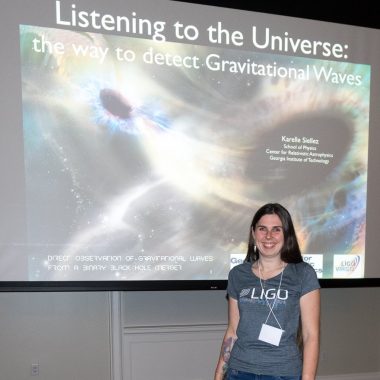Karelle Siellez, of Georgia Tech and the LIGO collaboration, presented recent results on the detection (and the confirmation of existence) of gravitational waves from two colliding black holes, a billion light years away.
 More than 60 physics students, faculty and interested members of the Elon community filed into the Clohan Theater on April 15 to hear a talk by Karelle Siellez of Georgia Tech.
More than 60 physics students, faculty and interested members of the Elon community filed into the Clohan Theater on April 15 to hear a talk by Karelle Siellez of Georgia Tech.
In “Listening to the Universe: The Way to Detect the First Gravitational Waves,” Siellez explained how the colliding black holes released the energy equivalent to three solar masses and how the incredibly precise earthbound LIGO experiment was able to detect the resulting gravitational waves, by which the fabric of space-time itself stretched as the ripples of the wave passed Earth.
Abstract:
On the 14th of September 2015, LIGO observed gravitational waves directly for the first time. The discovery of those ripples in the fabric of space-time, which carry information about their dramatic origins, confirmed a major prediction of Albert Einstein’s 1915 General Theory of Relativity. Those gravitational waves were produced during the final fraction of a second of the merger of two black holes to produce a single, more massive spinning black hole, an event that had been predicted but was never observed before. In this talk I will describe how this major discoveryhappened, and provide an overview of what we could do next in the new field of gravitational-wave astrophysics.


